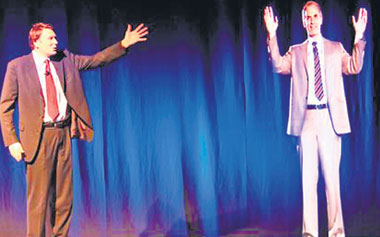If you use the Internet fairly regularly, you are among the first 1.3 billion in human history to have Internet access. There are of course a couple of billion people on Earth who are more preoccupied with survival at a more basic level – struggling to educate their children, busy trying to escape conflict zones with their lives intact, refugees and those without means to feed their families – than to worry about Internet access. Sandwiched between these two groups are a couple of billion people who will – over the next decade or so – enter the 'online' world, thanks to more affordable PCs that have entered the market – pioneered by the Asus Eee PC (TM). A large portion of them will also start using email, joining social networks and watching videos on Youtube.
 |
| CTO of Australian telecom giant Telstra, Hugh Bradlow (right), makes his presence felt at a conference in Adelaide using telepresence technology |
Internet traffic is doubling every two years. This s not so much due to a doubling of the number of users, but rather a result of new applications that are being introduced. Unlike in the early days of the Internet, people no longer get excited about email or web pages. Now we want our YouTube and soon we'll want the 'net to deliver our Hi Def surround sound TV, probably along with lots of things that are yet to be imagined.
Ten years ago the internet was one tenth as fast as it is today and the world did not come to an end! Twenty years ago, there was no Internet as we know it, and the world still functioned reasonably well. But with the networks reaching out to 'all corners of the globe' (try finding those!) and transmission speeds skyrocketing, new opportunities and possibilities have opened up.
At the moment most of the cables used for the net's fibre optic backbone carry 10Gbits per second – that's around 400 HDTV streams. But now the industry players like Cisco and Infusion say they can achieve 10 times that capacity using the same fibre optic cables buried below ground. This is possible because light signals can be separated in the same fibre optic cable by phasing them at different angles. This could always be done in theory, but now we have hardware that can phase the transmission signals and decode them accordingly at the receiving end. The signal processing done by boxes placed either end of the data cables has already led to commercially available speeds of 40 Gbps this year.
This phenomenal growth in available bandwidth also needs hardware at either end that are capable of processing the enormous quantities of data that flow through them and for that reason, increased network speeds has to be supported by additional receiving capacity and processing power.
The future of ultra high speed broadband will enable applications like telepresence – the next generation video conference that is much more lifelike. Such applications could in-turn help create effective virtual learning environments and enable many more such applications to come of age.
What will drive Internet TV through ultra high speed networks will be the fact that it can potentially be much cheaper to deliver than traditional broadcasting.
Digital content delivered through the Internet will also provide more interactivity while watching TV, perhaps allowing you to pause and replay live TV on the go. An ever increasing number of devices such as games consoles are entering the Internet and VoIP traffic is growing exponentially with the growing popularity of applications such as Skype.
Fortunately, the computer networks of tomorrow have already arrived. How we will use them may yet be unimagined, but they will certainly not be able to keep up with our growing demands. What will replace them when they are ailing?
Write to technopage@gmail.com and share your imagination.
Grapevine network...
As the buzz has it, public website search engine Cuil is the new Google challenger. "Cuil" is apparently pronounced "cool", and "an old Irish word for knowledge". The search engine was officially launched two weeks ago and the word is still out on Cuil's relevancy ranking, or the freshness of its index.
A larger index however, doesn't necessarily mean better results. The Cuil developers must have realized, that to be any kind of competition to Google, their index has to be huge; playing the age old 'mine is bigger than yours' and 'bigger is better' game that Yahoo! and Google once did.
|
